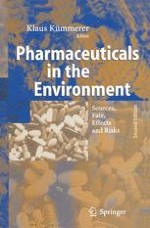2004 | OriginalPaper | Buchkapitel
Residues of Clofibric Acid, Ibuprofen and Diclofenac in the Aquatic Environment and their Elimination in Sewage Treatment and Drinking Water Production
verfasst von : C. Zwiener, F. H. Frimmel
Erschienen in: Pharmaceuticals in the Environment
Verlag: Springer Berlin Heidelberg
Enthalten in: Professional Book Archive
Aktivieren Sie unsere intelligente Suche, um passende Fachinhalte oder Patente zu finden.
Wählen Sie Textabschnitte aus um mit Künstlicher Intelligenz passenden Patente zu finden. powered by
Markieren Sie Textabschnitte, um KI-gestützt weitere passende Inhalte zu finden. powered by
Pharmaceuticals belong to the emerging issues in environmental chemistry. They are produced and administered for human and animal medical care. Due to the amount and type of application pharmaceuticals can reach the aquatic environment, in particular the ones used for medicine and veterinary drugs (Halling-Sørensen et al.1998). Being produced and applied with the aim of causing a biological effect, their occurrence in the environment is of ecotoxicological interest. In particular this is of importance for the antibiotics, but also for antineoplastics, hormones (compounds with endocrinic effects) and for various compounds and metabolites that have already been detected in sewage plant effluents and surface water in considerable concentrations (e.g. bezafibrate, clofibric acid, ibuprofen, carbamazepine, iopamidol) (Heberer 2002a; Ternes 2001; Kümmerer 2001; Ternes and Hirsch 2000; Stumpf et al.1999; Hirsch et al. 1999). More than 80 compounds, pharmaceuticals and several metabolites, have been detected in the aquatic environment in nine different countries of Europe, in Brazil, the US and Canada.
